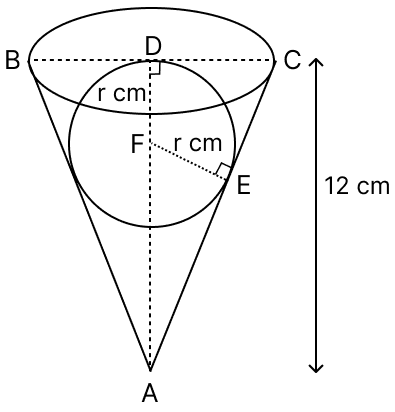Mathematics
A test tube consists of a hemisphere and a cylinder of the same radius. The volume of water required to fill the whole tube is cm3 and cm3 of water is required to fill the tube to a level which is 2 cm below the top of the tube. Find the radius of the tube and the length of its cylindrical part.

Mensuration
12 Likes
Answer
Let length of cylindrical part be h cm and radius of hemispherical and conical part be r cm.
Given,
Volume of water required to fill whole test tube = cm3.
Volume of water required to fill test tube upto a level which is 2 cm below the top of tube = cm3.
∴ Volume of water above 2 cm part of the test tube = = 77 cm3.
Volume of water in test tube = Volume of cylindrical part + Volume of hemispherical part = cm3.
Hence, radius of tube = 3.5 cm and length of cylindrical part = cm.
Answered By
6 Likes
Related Questions
A copper wire of diameter 6 mm is evenly wrapped on the cylinder of length 18 cm and diameter 49 cm to cover the whole surface. Find :
(i) the length
(ii) the volume of the wire.
A pool has a uniform circular cross section of radius 5 m and uniform depth 1.4 m. It is filled by a pipe which delivers water at the rate of 20 litres per sec. Calculate, in minutes, the time taken to fill the pool. If the pool is emptied in 42 min. by another cylindrical pipe through which water flows at 2 m per sec, calculate the radius of the pipe in cm.
A sphere is placed in an inverted hollow conical vessel of base radius 5 cm and vertical height 12 cm. If the highest point of the sphere is at the level of the base of the cone, find the radius of the sphere. Show that the volume of the sphere and the conical vessel are as 40 : 81.

The difference between the outer and the inner curved surface areas of a hollow cylinder, 14 cm long, is 88 sq. cm. Find the outer and the inner radii of the cylinder, given that the volume of metal used is 176 cu. cm.